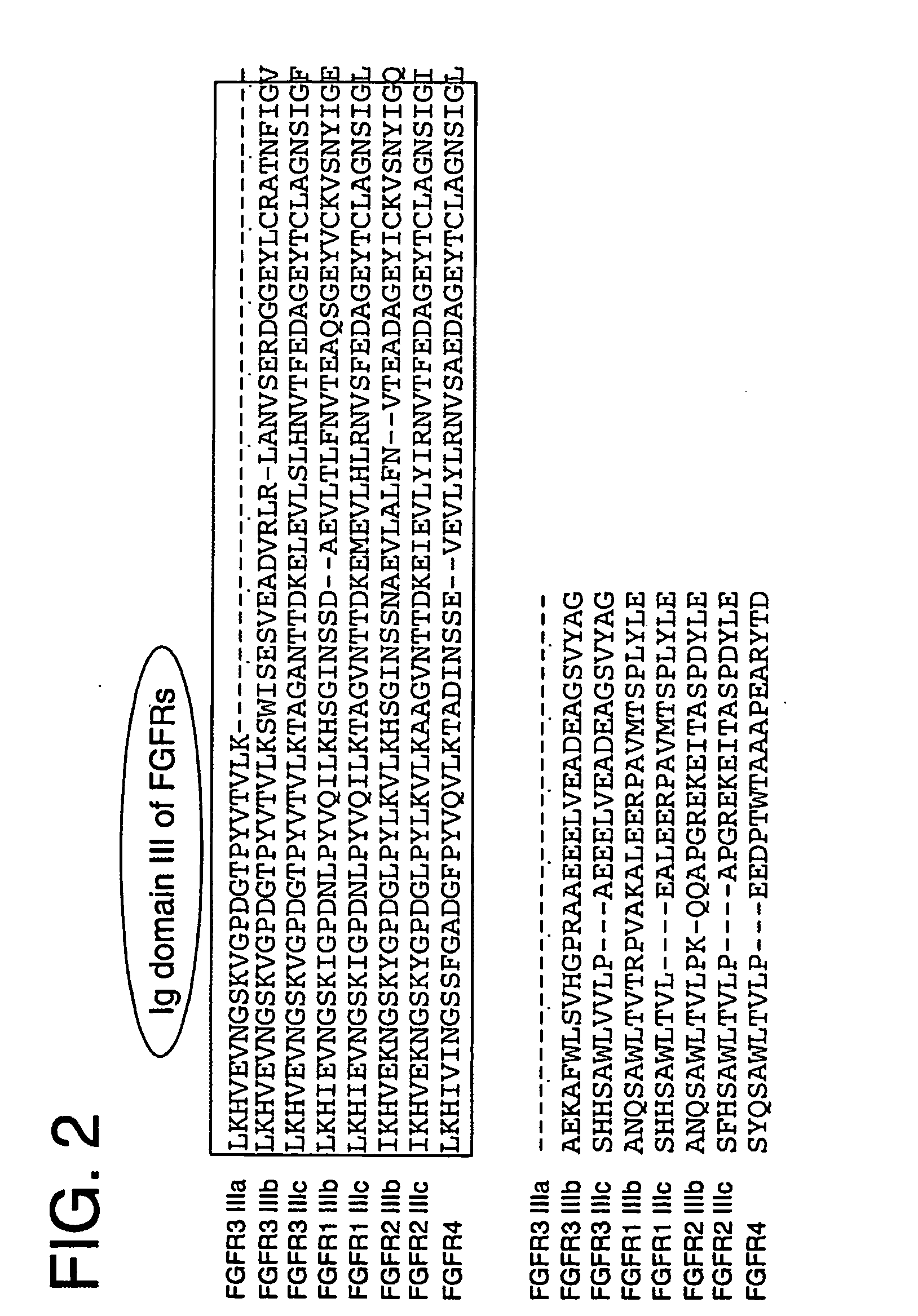Hair growth methods using fgfr3 extracellular domins
a hair growth and extracellular dominus technology, applied in the field of hair growth promotion, can solve the problems of limited treatment options for hair growth, wide hair growth problems, and minoxidil, while relatively safe, is only moderately effective, etc., to achieve positive side effects, promote hair growth, and promote hair growth
- Summary
- Abstract
- Description
- Claims
- Application Information
AI Technical Summary
Benefits of technology
Problems solved by technology
Method used
Image
Examples
example 1
Construction of an FGFR3 ECD-Fc Fusion Molecule
[0102]An FGFR3 ECD-Fc having a 3 amino acid carboxy-terminal deletion from the FGFR3-IIIc ECD (“FGFR3 ECD Δ3-Fc” or “FGFR3 ECD-Fc”) fused to Fc with a GS linker (SEQ ID NO: 33) was subcloned into the pTT5 and pDEF38 vectors using PCR and conventional subcloning techniques.
[0103]The primary sequence and domain structure of the FGFR3 ECD moiety in the FGFR3 ECD Δ3-Fc construct is shown in FIG. 1. FIG. 2 shows an amino acid sequence alignment of a portion of the C-terminal region of FGFR ECDs, denoting Ig domain III.
[0104]For transient expression in 293-6E cells, the vector pTT5 (Biotechnology Research Institute, Montreal, Canada) was used. For expression of the fusion proteins in CHO-S host cells, we used the pTT5 and pDEF38 (ICOS Corporation, Bothell, Wash.) vectors. DG44 (Invitrogen, Carlsbad, Calif.) is a derivative cell line of the CHO-S cell line that we have found can give higher yields of recombinant proteins. For expression of the...
example 2
Purification of Expressed Protein
[0105]An FGFR3 ECD-Fc fusion protein expressed from recombinant host cells was purified from the cell culture supernatant using a first purification step of Protein-A affinity chromatography, followed by a second purification step of butyl hydrophobic interaction chromatography. For the Protein-A affinity chromatography step, the components of the media were separated on a Mabselect Protein-A Sepharose column (GE Healthcare Bio-Sciences, Piscataway, N.J.), which will bind to the Fc region of the fusion molecule. The column was equilibrated with ten column volumes of a sterile buffer of 10 mM Tris, 100 mM NaCl, pH 8.0; then the cell culture supernatant was applied to the column. The column was washed with eight column volumes of sterile 10 mM Tris, 100 mM NaCl buffer, pH 8.0. The bound material, including the fusion protein, was then eluted at a rate of 10 ml / min with a one step elution using seven column volumes of elution buffer (100 mM glycine, 100...
example 3
Transient Expression of Fusion Protein in CHO-S Host Cells
[0108]An FGFR3 ECD-Fc fusion protein was transiently expressed in CHO-S cells. Briefly, a 500 ml culture of CHO-S cells (Invitrogen) was established by inoculating 0.5×106 cells / ml in fresh 37° C. Freestyle CHO medium containing 8 mM L-Glutamine (Invitrogen). The cells were grown in a 2 l plastic flask and were derived from a seed strain that was continuously maintained up to passage 20. The following day, the cells were counted and diluted, if necessary, to 1×106 cells / ml in 37° C. Freestyle CHO medium (Invitrogen) with a cell viability greater than 95%. The cells were transfected by transferring 10 ml of 37° C. OptiPRO SFM medium containing 8 mM L-Glutamine (dilution media) into two 50 ml tubes. To the first tube (A), 625 ul of FreestyleMax transfection reagent (Invitrogen) were added. To the second tube (B), 625 ug of DNA were added. Both tubes were gently mixed by inverting, and the contents of tube A were immediately add...
PUM
| Property | Measurement | Unit |
|---|---|---|
| equilibrium dissociation constant | aaaaa | aaaaa |
| equilibrium dissociation constant | aaaaa | aaaaa |
| equilibrium dissociation constant | aaaaa | aaaaa |
Abstract
Description
Claims
Application Information
 Login to View More
Login to View More - R&D
- Intellectual Property
- Life Sciences
- Materials
- Tech Scout
- Unparalleled Data Quality
- Higher Quality Content
- 60% Fewer Hallucinations
Browse by: Latest US Patents, China's latest patents, Technical Efficacy Thesaurus, Application Domain, Technology Topic, Popular Technical Reports.
© 2025 PatSnap. All rights reserved.Legal|Privacy policy|Modern Slavery Act Transparency Statement|Sitemap|About US| Contact US: help@patsnap.com



